HR Strategies for Multinational Companies: A Nestle Case Study Report
VerifiedAdded on 2021/02/20
|20
|4220
|51
Report
AI Summary
This report examines how multinational companies, specifically Nestle, improve their recruitment, selection, and training processes to meet international requirements. It begins with an introduction to globalization and its impact on businesses, followed by a project management plan outlining costs, scope, time, quality, communication, risks, and resources. The report includes a Work Breakdown Structure and Gantt chart. It then details the research methodology, including quantitative and qualitative approaches, data collection methods (primary and secondary), and a questionnaire used to gather data from respondents. The analysis of the research data is presented, followed by recommendations and a reflection on the findings. The research aims to assess Nestle's current recruitment, selection, and training processes and evaluate the benefits and challenges of training a diverse international workforce, ultimately aiming to improve HR practices within the company and enhance its global competitiveness. The report concludes with an overview of the research findings and recommendations for Nestle.

Managing a Successful
Business Project
Business Project
Paraphrase This Document
Need a fresh take? Get an instant paraphrase of this document with our AI Paraphraser

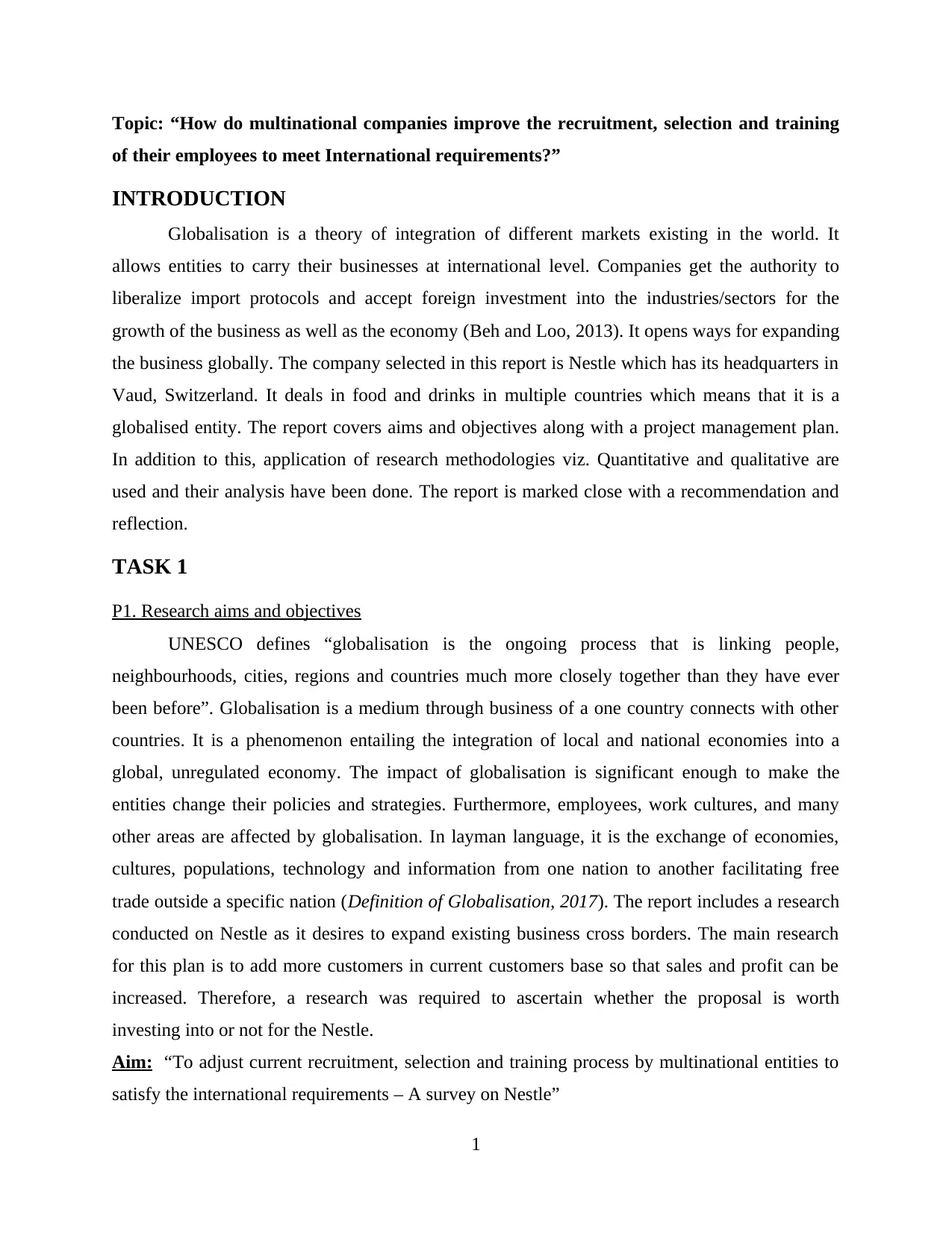
Topic: “How do multinational companies improve the recruitment, selection and training
of their employees to meet International requirements?”
INTRODUCTION
Globalisation is a theory of integration of different markets existing in the world. It
allows entities to carry their businesses at international level. Companies get the authority to
liberalize import protocols and accept foreign investment into the industries/sectors for the
growth of the business as well as the economy (Beh and Loo, 2013). It opens ways for expanding
the business globally. The company selected in this report is Nestle which has its headquarters in
Vaud, Switzerland. It deals in food and drinks in multiple countries which means that it is a
globalised entity. The report covers aims and objectives along with a project management plan.
In addition to this, application of research methodologies viz. Quantitative and qualitative are
used and their analysis have been done. The report is marked close with a recommendation and
reflection.
TASK 1
P1. Research aims and objectives
UNESCO defines “globalisation is the ongoing process that is linking people,
neighbourhoods, cities, regions and countries much more closely together than they have ever
been before”. Globalisation is a medium through business of a one country connects with other
countries. It is a phenomenon entailing the integration of local and national economies into a
global, unregulated economy. The impact of globalisation is significant enough to make the
entities change their policies and strategies. Furthermore, employees, work cultures, and many
other areas are affected by globalisation. In layman language, it is the exchange of economies,
cultures, populations, technology and information from one nation to another facilitating free
trade outside a specific nation (Definition of Globalisation, 2017). The report includes a research
conducted on Nestle as it desires to expand existing business cross borders. The main research
for this plan is to add more customers in current customers base so that sales and profit can be
increased. Therefore, a research was required to ascertain whether the proposal is worth
investing into or not for the Nestle.
Aim: “To adjust current recruitment, selection and training process by multinational entities to
satisfy the international requirements – A survey on Nestle”
1
of their employees to meet International requirements?”
INTRODUCTION
Globalisation is a theory of integration of different markets existing in the world. It
allows entities to carry their businesses at international level. Companies get the authority to
liberalize import protocols and accept foreign investment into the industries/sectors for the
growth of the business as well as the economy (Beh and Loo, 2013). It opens ways for expanding
the business globally. The company selected in this report is Nestle which has its headquarters in
Vaud, Switzerland. It deals in food and drinks in multiple countries which means that it is a
globalised entity. The report covers aims and objectives along with a project management plan.
In addition to this, application of research methodologies viz. Quantitative and qualitative are
used and their analysis have been done. The report is marked close with a recommendation and
reflection.
TASK 1
P1. Research aims and objectives
UNESCO defines “globalisation is the ongoing process that is linking people,
neighbourhoods, cities, regions and countries much more closely together than they have ever
been before”. Globalisation is a medium through business of a one country connects with other
countries. It is a phenomenon entailing the integration of local and national economies into a
global, unregulated economy. The impact of globalisation is significant enough to make the
entities change their policies and strategies. Furthermore, employees, work cultures, and many
other areas are affected by globalisation. In layman language, it is the exchange of economies,
cultures, populations, technology and information from one nation to another facilitating free
trade outside a specific nation (Definition of Globalisation, 2017). The report includes a research
conducted on Nestle as it desires to expand existing business cross borders. The main research
for this plan is to add more customers in current customers base so that sales and profit can be
increased. Therefore, a research was required to ascertain whether the proposal is worth
investing into or not for the Nestle.
Aim: “To adjust current recruitment, selection and training process by multinational entities to
satisfy the international requirements – A survey on Nestle”
1
⊘ This is a preview!⊘
Do you want full access?
Subscribe today to unlock all pages.

Trusted by 1+ million students worldwide
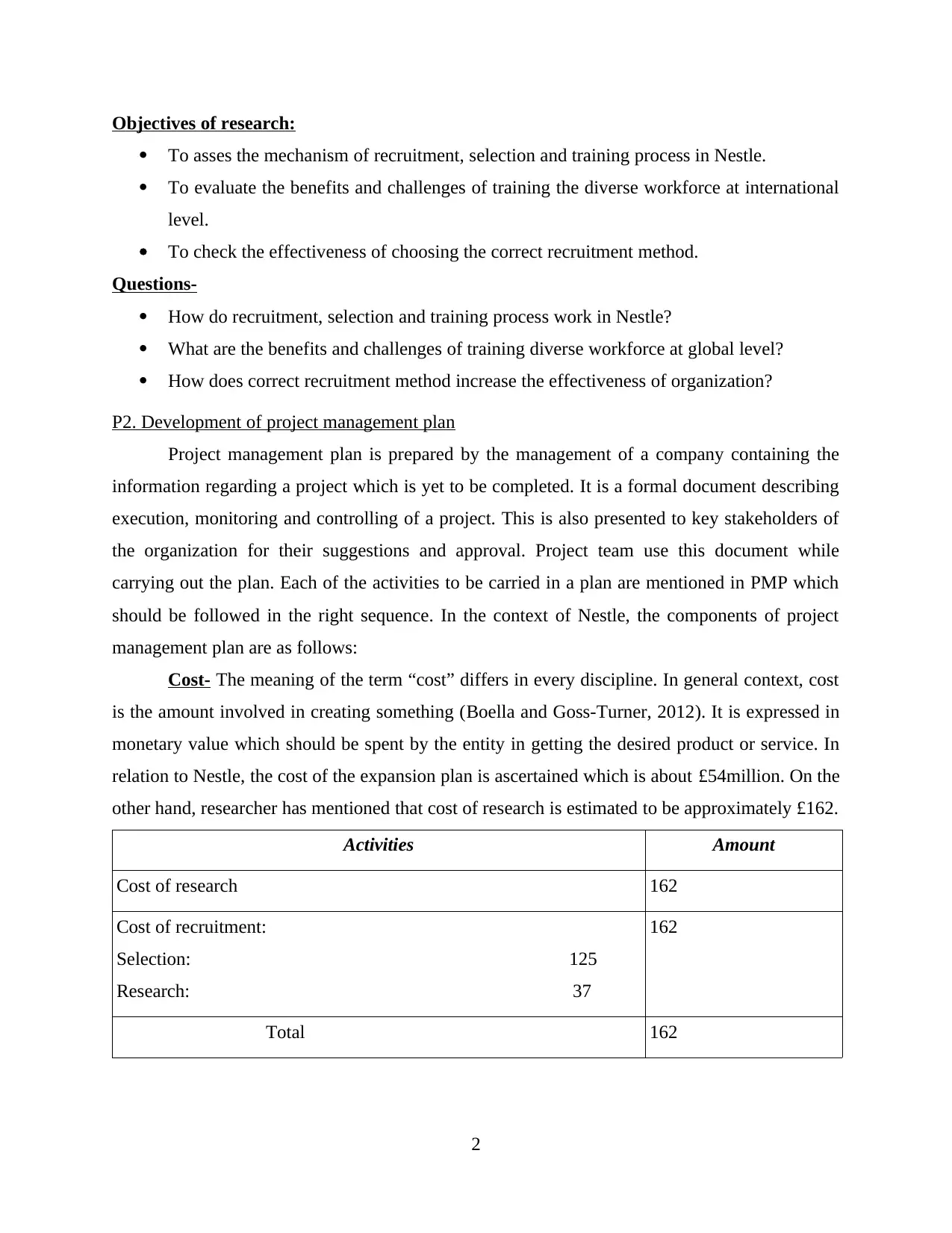
Objectives of research:
To asses the mechanism of recruitment, selection and training process in Nestle.
To evaluate the benefits and challenges of training the diverse workforce at international
level.
To check the effectiveness of choosing the correct recruitment method.
Questions-
How do recruitment, selection and training process work in Nestle?
What are the benefits and challenges of training diverse workforce at global level?
How does correct recruitment method increase the effectiveness of organization?
P2. Development of project management plan
Project management plan is prepared by the management of a company containing the
information regarding a project which is yet to be completed. It is a formal document describing
execution, monitoring and controlling of a project. This is also presented to key stakeholders of
the organization for their suggestions and approval. Project team use this document while
carrying out the plan. Each of the activities to be carried in a plan are mentioned in PMP which
should be followed in the right sequence. In the context of Nestle, the components of project
management plan are as follows:
Cost- The meaning of the term “cost” differs in every discipline. In general context, cost
is the amount involved in creating something (Boella and Goss-Turner, 2012). It is expressed in
monetary value which should be spent by the entity in getting the desired product or service. In
relation to Nestle, the cost of the expansion plan is ascertained which is about £54million. On the
other hand, researcher has mentioned that cost of research is estimated to be approximately £162.
Activities Amount
Cost of research 162
Cost of recruitment:
Selection: 125
Research: 37
162
Total 162
2
To asses the mechanism of recruitment, selection and training process in Nestle.
To evaluate the benefits and challenges of training the diverse workforce at international
level.
To check the effectiveness of choosing the correct recruitment method.
Questions-
How do recruitment, selection and training process work in Nestle?
What are the benefits and challenges of training diverse workforce at global level?
How does correct recruitment method increase the effectiveness of organization?
P2. Development of project management plan
Project management plan is prepared by the management of a company containing the
information regarding a project which is yet to be completed. It is a formal document describing
execution, monitoring and controlling of a project. This is also presented to key stakeholders of
the organization for their suggestions and approval. Project team use this document while
carrying out the plan. Each of the activities to be carried in a plan are mentioned in PMP which
should be followed in the right sequence. In the context of Nestle, the components of project
management plan are as follows:
Cost- The meaning of the term “cost” differs in every discipline. In general context, cost
is the amount involved in creating something (Boella and Goss-Turner, 2012). It is expressed in
monetary value which should be spent by the entity in getting the desired product or service. In
relation to Nestle, the cost of the expansion plan is ascertained which is about £54million. On the
other hand, researcher has mentioned that cost of research is estimated to be approximately £162.
Activities Amount
Cost of research 162
Cost of recruitment:
Selection: 125
Research: 37
162
Total 162
2
Paraphrase This Document
Need a fresh take? Get an instant paraphrase of this document with our AI Paraphraser
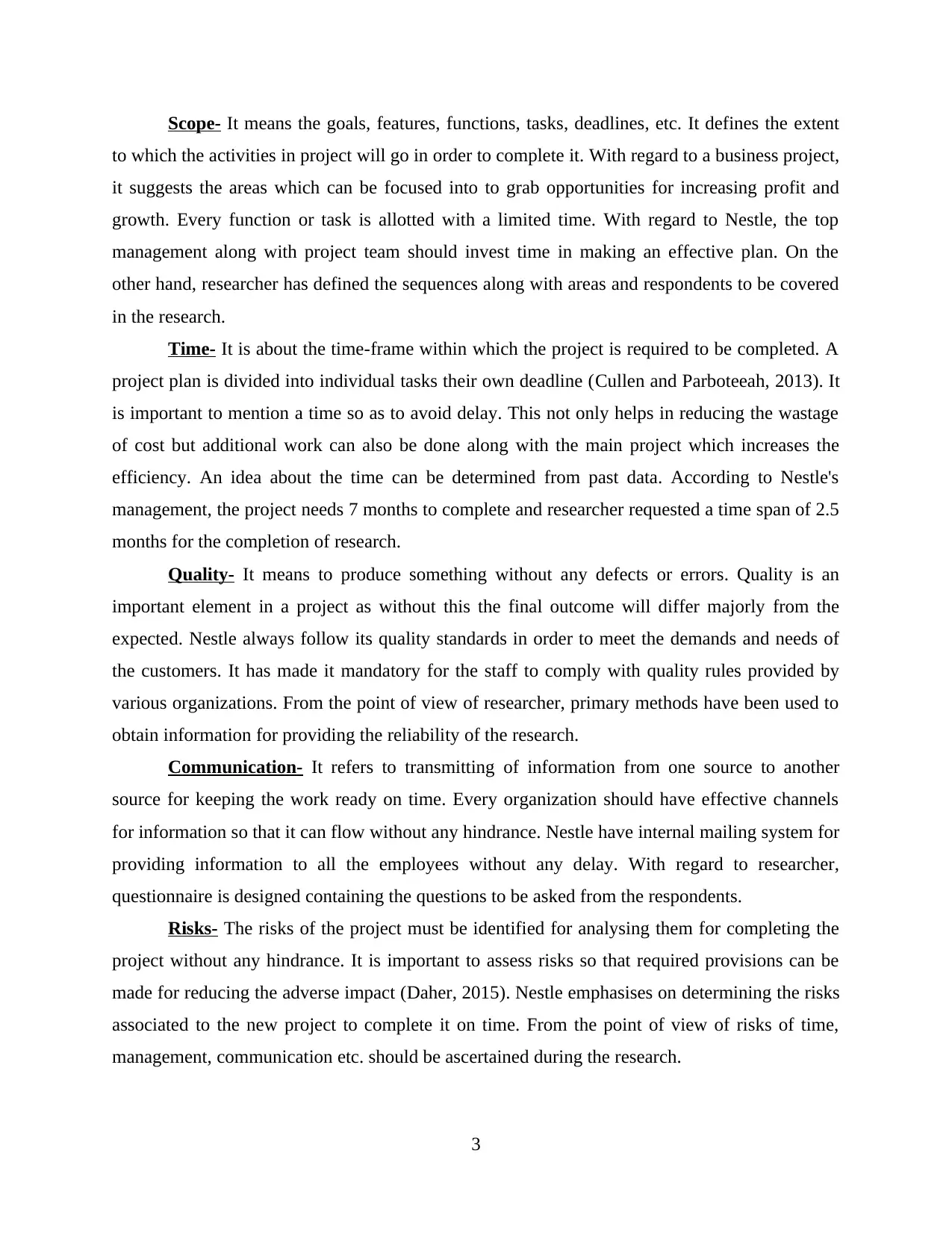
Scope- It means the goals, features, functions, tasks, deadlines, etc. It defines the extent
to which the activities in project will go in order to complete it. With regard to a business project,
it suggests the areas which can be focused into to grab opportunities for increasing profit and
growth. Every function or task is allotted with a limited time. With regard to Nestle, the top
management along with project team should invest time in making an effective plan. On the
other hand, researcher has defined the sequences along with areas and respondents to be covered
in the research.
Time- It is about the time-frame within which the project is required to be completed. A
project plan is divided into individual tasks their own deadline (Cullen and Parboteeah, 2013). It
is important to mention a time so as to avoid delay. This not only helps in reducing the wastage
of cost but additional work can also be done along with the main project which increases the
efficiency. An idea about the time can be determined from past data. According to Nestle's
management, the project needs 7 months to complete and researcher requested a time span of 2.5
months for the completion of research.
Quality- It means to produce something without any defects or errors. Quality is an
important element in a project as without this the final outcome will differ majorly from the
expected. Nestle always follow its quality standards in order to meet the demands and needs of
the customers. It has made it mandatory for the staff to comply with quality rules provided by
various organizations. From the point of view of researcher, primary methods have been used to
obtain information for providing the reliability of the research.
Communication- It refers to transmitting of information from one source to another
source for keeping the work ready on time. Every organization should have effective channels
for information so that it can flow without any hindrance. Nestle have internal mailing system for
providing information to all the employees without any delay. With regard to researcher,
questionnaire is designed containing the questions to be asked from the respondents.
Risks- The risks of the project must be identified for analysing them for completing the
project without any hindrance. It is important to assess risks so that required provisions can be
made for reducing the adverse impact (Daher, 2015). Nestle emphasises on determining the risks
associated to the new project to complete it on time. From the point of view of risks of time,
management, communication etc. should be ascertained during the research.
3
to which the activities in project will go in order to complete it. With regard to a business project,
it suggests the areas which can be focused into to grab opportunities for increasing profit and
growth. Every function or task is allotted with a limited time. With regard to Nestle, the top
management along with project team should invest time in making an effective plan. On the
other hand, researcher has defined the sequences along with areas and respondents to be covered
in the research.
Time- It is about the time-frame within which the project is required to be completed. A
project plan is divided into individual tasks their own deadline (Cullen and Parboteeah, 2013). It
is important to mention a time so as to avoid delay. This not only helps in reducing the wastage
of cost but additional work can also be done along with the main project which increases the
efficiency. An idea about the time can be determined from past data. According to Nestle's
management, the project needs 7 months to complete and researcher requested a time span of 2.5
months for the completion of research.
Quality- It means to produce something without any defects or errors. Quality is an
important element in a project as without this the final outcome will differ majorly from the
expected. Nestle always follow its quality standards in order to meet the demands and needs of
the customers. It has made it mandatory for the staff to comply with quality rules provided by
various organizations. From the point of view of researcher, primary methods have been used to
obtain information for providing the reliability of the research.
Communication- It refers to transmitting of information from one source to another
source for keeping the work ready on time. Every organization should have effective channels
for information so that it can flow without any hindrance. Nestle have internal mailing system for
providing information to all the employees without any delay. With regard to researcher,
questionnaire is designed containing the questions to be asked from the respondents.
Risks- The risks of the project must be identified for analysing them for completing the
project without any hindrance. It is important to assess risks so that required provisions can be
made for reducing the adverse impact (Daher, 2015). Nestle emphasises on determining the risks
associated to the new project to complete it on time. From the point of view of risks of time,
management, communication etc. should be ascertained during the research.
3
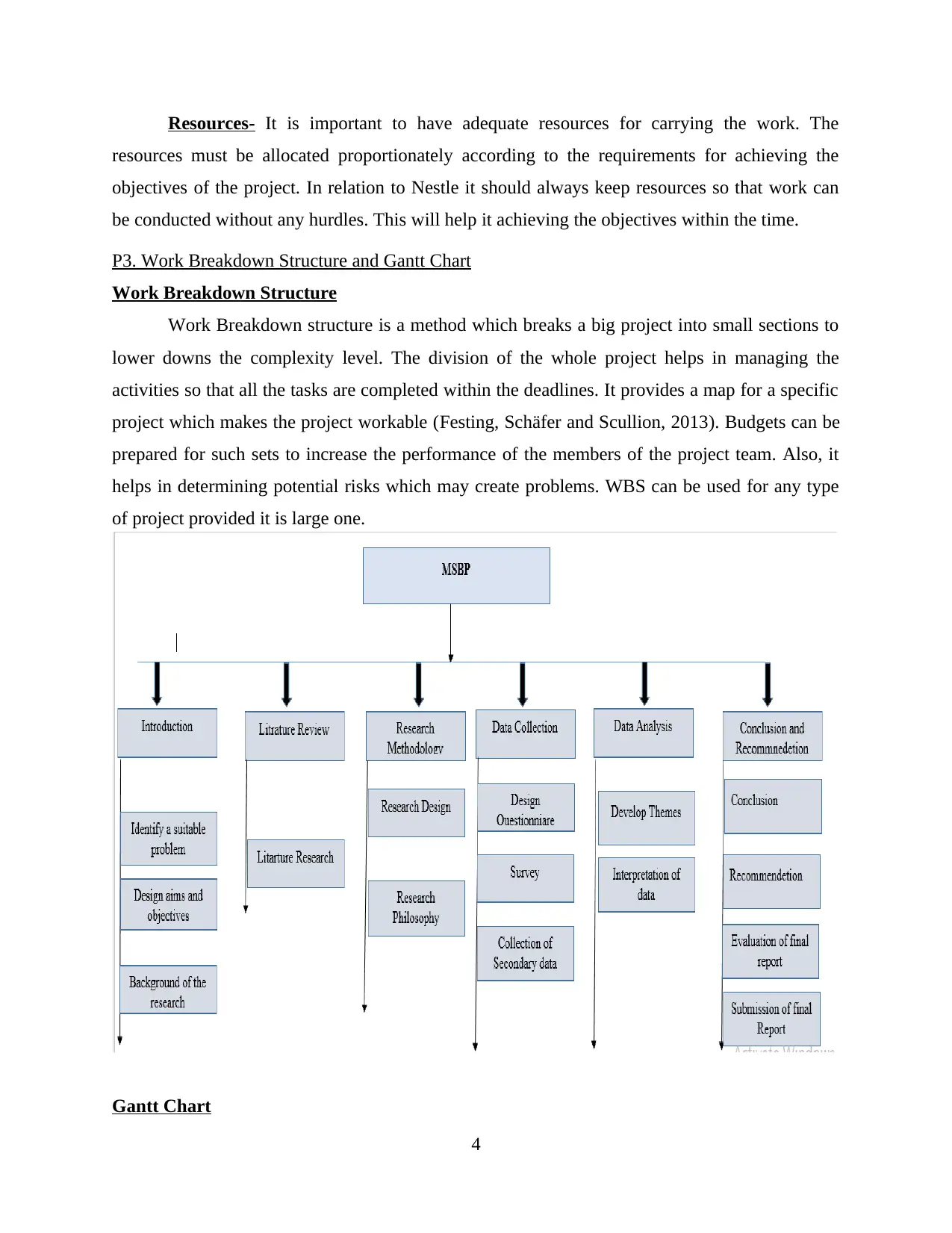
Resources- It is important to have adequate resources for carrying the work. The
resources must be allocated proportionately according to the requirements for achieving the
objectives of the project. In relation to Nestle it should always keep resources so that work can
be conducted without any hurdles. This will help it achieving the objectives within the time.
P3. Work Breakdown Structure and Gantt Chart
Work Breakdown Structure
Work Breakdown structure is a method which breaks a big project into small sections to
lower downs the complexity level. The division of the whole project helps in managing the
activities so that all the tasks are completed within the deadlines. It provides a map for a specific
project which makes the project workable (Festing, Schäfer and Scullion, 2013). Budgets can be
prepared for such sets to increase the performance of the members of the project team. Also, it
helps in determining potential risks which may create problems. WBS can be used for any type
of project provided it is large one.
Gantt Chart
4
resources must be allocated proportionately according to the requirements for achieving the
objectives of the project. In relation to Nestle it should always keep resources so that work can
be conducted without any hurdles. This will help it achieving the objectives within the time.
P3. Work Breakdown Structure and Gantt Chart
Work Breakdown Structure
Work Breakdown structure is a method which breaks a big project into small sections to
lower downs the complexity level. The division of the whole project helps in managing the
activities so that all the tasks are completed within the deadlines. It provides a map for a specific
project which makes the project workable (Festing, Schäfer and Scullion, 2013). Budgets can be
prepared for such sets to increase the performance of the members of the project team. Also, it
helps in determining potential risks which may create problems. WBS can be used for any type
of project provided it is large one.
Gantt Chart
4
⊘ This is a preview!⊘
Do you want full access?
Subscribe today to unlock all pages.

Trusted by 1+ million students worldwide
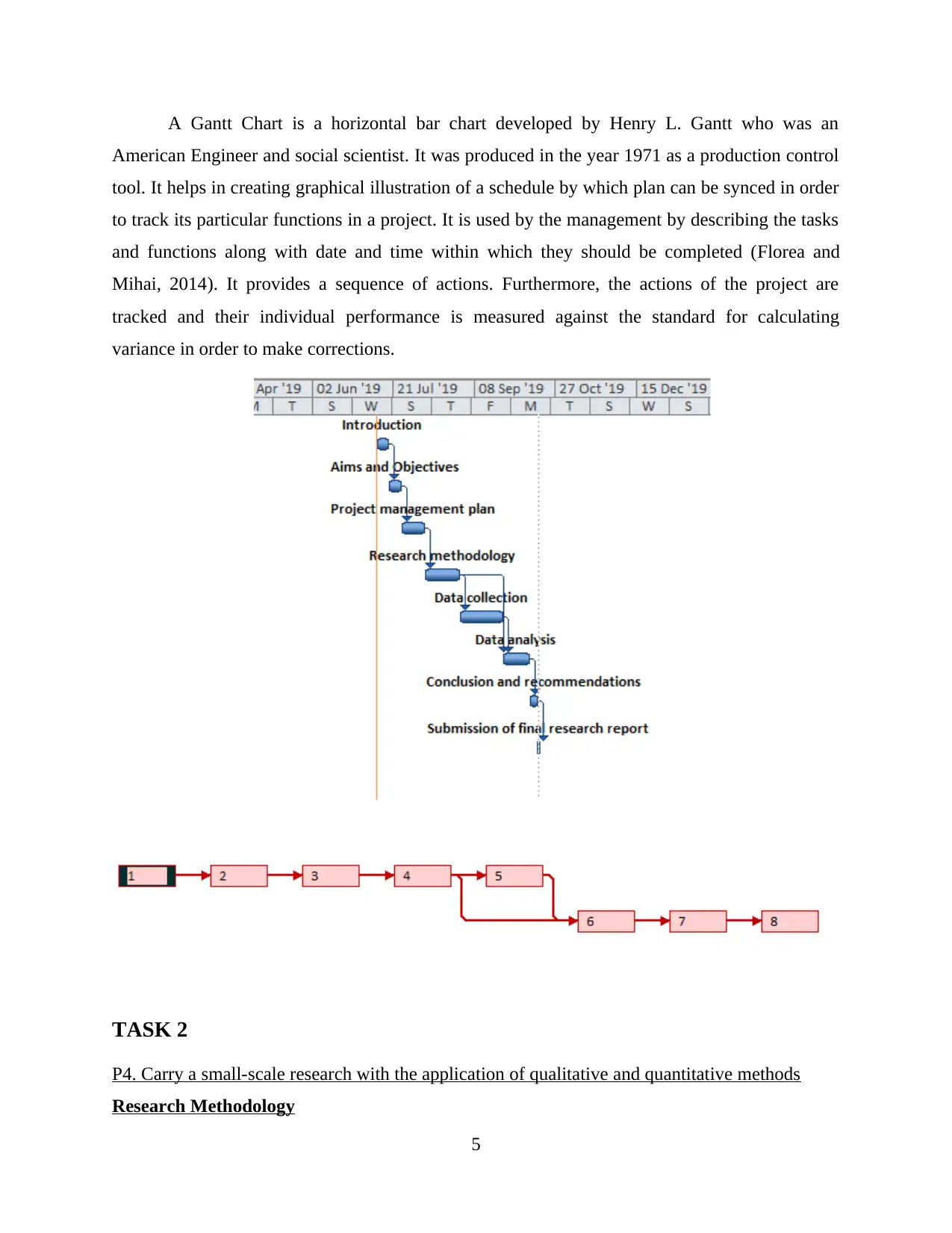
A Gantt Chart is a horizontal bar chart developed by Henry L. Gantt who was an
American Engineer and social scientist. It was produced in the year 1971 as a production control
tool. It helps in creating graphical illustration of a schedule by which plan can be synced in order
to track its particular functions in a project. It is used by the management by describing the tasks
and functions along with date and time within which they should be completed (Florea and
Mihai, 2014). It provides a sequence of actions. Furthermore, the actions of the project are
tracked and their individual performance is measured against the standard for calculating
variance in order to make corrections.
TASK 2
P4. Carry a small-scale research with the application of qualitative and quantitative methods
Research Methodology
5
American Engineer and social scientist. It was produced in the year 1971 as a production control
tool. It helps in creating graphical illustration of a schedule by which plan can be synced in order
to track its particular functions in a project. It is used by the management by describing the tasks
and functions along with date and time within which they should be completed (Florea and
Mihai, 2014). It provides a sequence of actions. Furthermore, the actions of the project are
tracked and their individual performance is measured against the standard for calculating
variance in order to make corrections.
TASK 2
P4. Carry a small-scale research with the application of qualitative and quantitative methods
Research Methodology
5
Paraphrase This Document
Need a fresh take? Get an instant paraphrase of this document with our AI Paraphraser
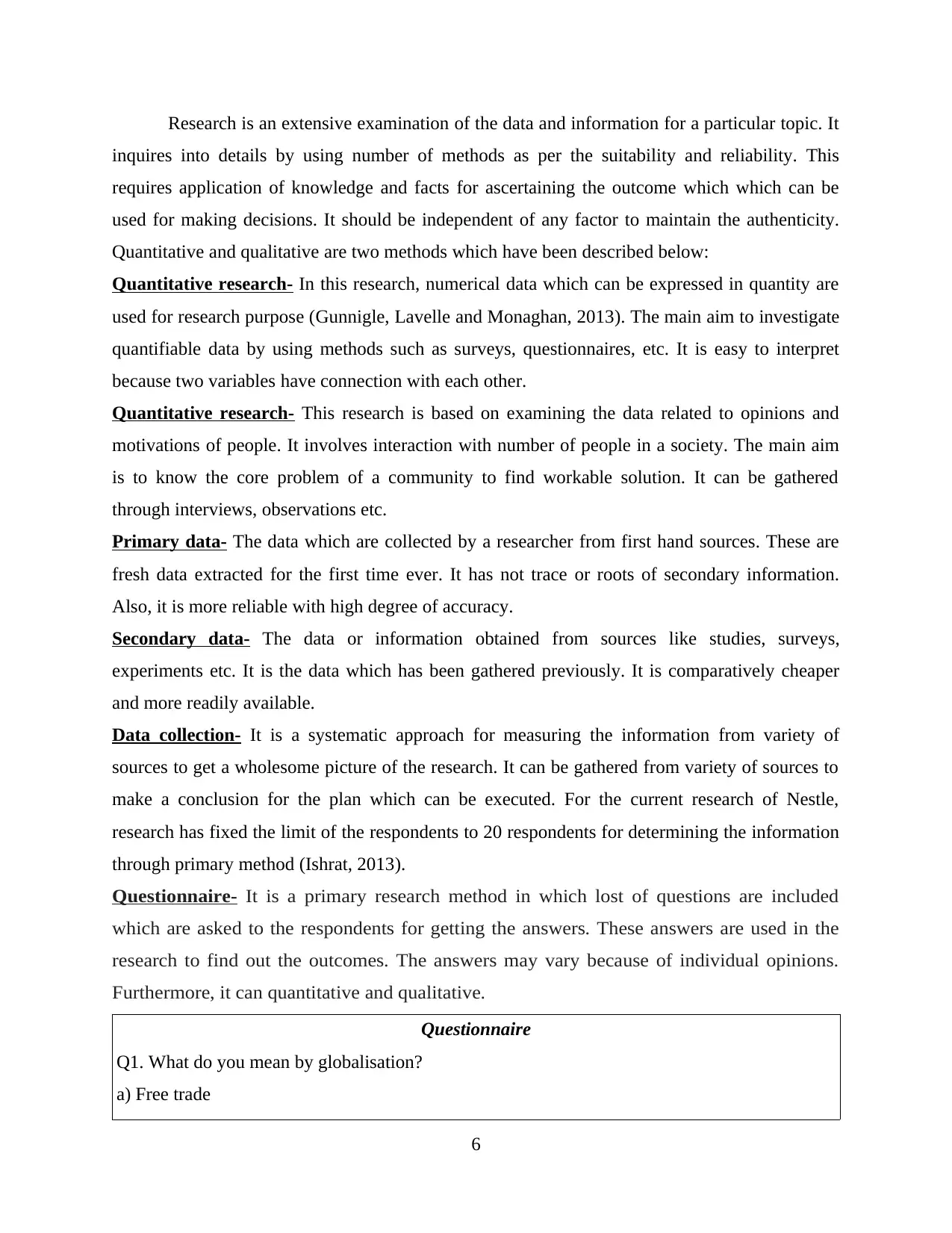
Research is an extensive examination of the data and information for a particular topic. It
inquires into details by using number of methods as per the suitability and reliability. This
requires application of knowledge and facts for ascertaining the outcome which which can be
used for making decisions. It should be independent of any factor to maintain the authenticity.
Quantitative and qualitative are two methods which have been described below:
Quantitative research- In this research, numerical data which can be expressed in quantity are
used for research purpose (Gunnigle, Lavelle and Monaghan, 2013). The main aim to investigate
quantifiable data by using methods such as surveys, questionnaires, etc. It is easy to interpret
because two variables have connection with each other.
Quantitative research- This research is based on examining the data related to opinions and
motivations of people. It involves interaction with number of people in a society. The main aim
is to know the core problem of a community to find workable solution. It can be gathered
through interviews, observations etc.
Primary data- The data which are collected by a researcher from first hand sources. These are
fresh data extracted for the first time ever. It has not trace or roots of secondary information.
Also, it is more reliable with high degree of accuracy.
Secondary data- The data or information obtained from sources like studies, surveys,
experiments etc. It is the data which has been gathered previously. It is comparatively cheaper
and more readily available.
Data collection- It is a systematic approach for measuring the information from variety of
sources to get a wholesome picture of the research. It can be gathered from variety of sources to
make a conclusion for the plan which can be executed. For the current research of Nestle,
research has fixed the limit of the respondents to 20 respondents for determining the information
through primary method (Ishrat, 2013).
Questionnaire- It is a primary research method in which lost of questions are included
which are asked to the respondents for getting the answers. These answers are used in the
research to find out the outcomes. The answers may vary because of individual opinions.
Furthermore, it can quantitative and qualitative.
Questionnaire
Q1. What do you mean by globalisation?
a) Free trade
6
inquires into details by using number of methods as per the suitability and reliability. This
requires application of knowledge and facts for ascertaining the outcome which which can be
used for making decisions. It should be independent of any factor to maintain the authenticity.
Quantitative and qualitative are two methods which have been described below:
Quantitative research- In this research, numerical data which can be expressed in quantity are
used for research purpose (Gunnigle, Lavelle and Monaghan, 2013). The main aim to investigate
quantifiable data by using methods such as surveys, questionnaires, etc. It is easy to interpret
because two variables have connection with each other.
Quantitative research- This research is based on examining the data related to opinions and
motivations of people. It involves interaction with number of people in a society. The main aim
is to know the core problem of a community to find workable solution. It can be gathered
through interviews, observations etc.
Primary data- The data which are collected by a researcher from first hand sources. These are
fresh data extracted for the first time ever. It has not trace or roots of secondary information.
Also, it is more reliable with high degree of accuracy.
Secondary data- The data or information obtained from sources like studies, surveys,
experiments etc. It is the data which has been gathered previously. It is comparatively cheaper
and more readily available.
Data collection- It is a systematic approach for measuring the information from variety of
sources to get a wholesome picture of the research. It can be gathered from variety of sources to
make a conclusion for the plan which can be executed. For the current research of Nestle,
research has fixed the limit of the respondents to 20 respondents for determining the information
through primary method (Ishrat, 2013).
Questionnaire- It is a primary research method in which lost of questions are included
which are asked to the respondents for getting the answers. These answers are used in the
research to find out the outcomes. The answers may vary because of individual opinions.
Furthermore, it can quantitative and qualitative.
Questionnaire
Q1. What do you mean by globalisation?
a) Free trade
6
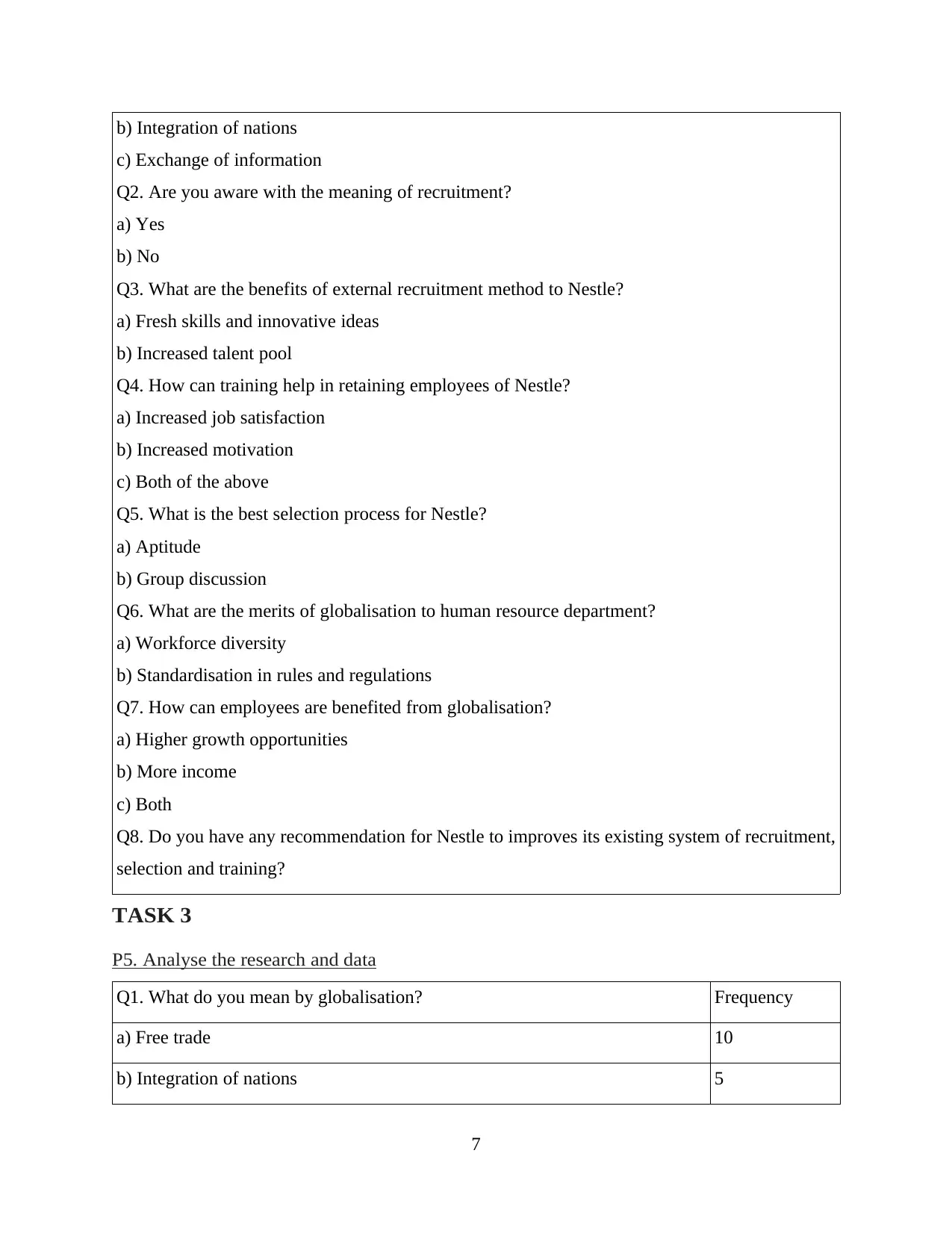
b) Integration of nations
c) Exchange of information
Q2. Are you aware with the meaning of recruitment?
a) Yes
b) No
Q3. What are the benefits of external recruitment method to Nestle?
a) Fresh skills and innovative ideas
b) Increased talent pool
Q4. How can training help in retaining employees of Nestle?
a) Increased job satisfaction
b) Increased motivation
c) Both of the above
Q5. What is the best selection process for Nestle?
a) Aptitude
b) Group discussion
Q6. What are the merits of globalisation to human resource department?
a) Workforce diversity
b) Standardisation in rules and regulations
Q7. How can employees are benefited from globalisation?
a) Higher growth opportunities
b) More income
c) Both
Q8. Do you have any recommendation for Nestle to improves its existing system of recruitment,
selection and training?
TASK 3
P5. Analyse the research and data
Q1. What do you mean by globalisation? Frequency
a) Free trade 10
b) Integration of nations 5
7
c) Exchange of information
Q2. Are you aware with the meaning of recruitment?
a) Yes
b) No
Q3. What are the benefits of external recruitment method to Nestle?
a) Fresh skills and innovative ideas
b) Increased talent pool
Q4. How can training help in retaining employees of Nestle?
a) Increased job satisfaction
b) Increased motivation
c) Both of the above
Q5. What is the best selection process for Nestle?
a) Aptitude
b) Group discussion
Q6. What are the merits of globalisation to human resource department?
a) Workforce diversity
b) Standardisation in rules and regulations
Q7. How can employees are benefited from globalisation?
a) Higher growth opportunities
b) More income
c) Both
Q8. Do you have any recommendation for Nestle to improves its existing system of recruitment,
selection and training?
TASK 3
P5. Analyse the research and data
Q1. What do you mean by globalisation? Frequency
a) Free trade 10
b) Integration of nations 5
7
⊘ This is a preview!⊘
Do you want full access?
Subscribe today to unlock all pages.

Trusted by 1+ million students worldwide

c) Exchange of information 5
Q2. Are you aware with the meaning of recruitment? Frequency
a) Yes 15
b) No 5
Q3. What are the benefits of external recruitment method to Nestle? Frequency
a) Fresh skills and innovative ideas 9
b) Increased talent pool 11
Q4. How can training help in retaining employees of Nestle? Frequency
a) Increased job satisfaction 4
b) Increased motivation 6
c) Both of the above 10
Q5. What is the best selection process for Nestle? Frequency
a) Aptitude 12
b) Group discussion 8
Q6. What are the merits of globalisation to human resource department? Frequency
a) Workforce diversity 10
b) Standardisation in rules and regulations 10
Q7. How can employees are benefited from globalisation? Frequency
a) Higher growth opportunities 8
8
Q2. Are you aware with the meaning of recruitment? Frequency
a) Yes 15
b) No 5
Q3. What are the benefits of external recruitment method to Nestle? Frequency
a) Fresh skills and innovative ideas 9
b) Increased talent pool 11
Q4. How can training help in retaining employees of Nestle? Frequency
a) Increased job satisfaction 4
b) Increased motivation 6
c) Both of the above 10
Q5. What is the best selection process for Nestle? Frequency
a) Aptitude 12
b) Group discussion 8
Q6. What are the merits of globalisation to human resource department? Frequency
a) Workforce diversity 10
b) Standardisation in rules and regulations 10
Q7. How can employees are benefited from globalisation? Frequency
a) Higher growth opportunities 8
8
Paraphrase This Document
Need a fresh take? Get an instant paraphrase of this document with our AI Paraphraser
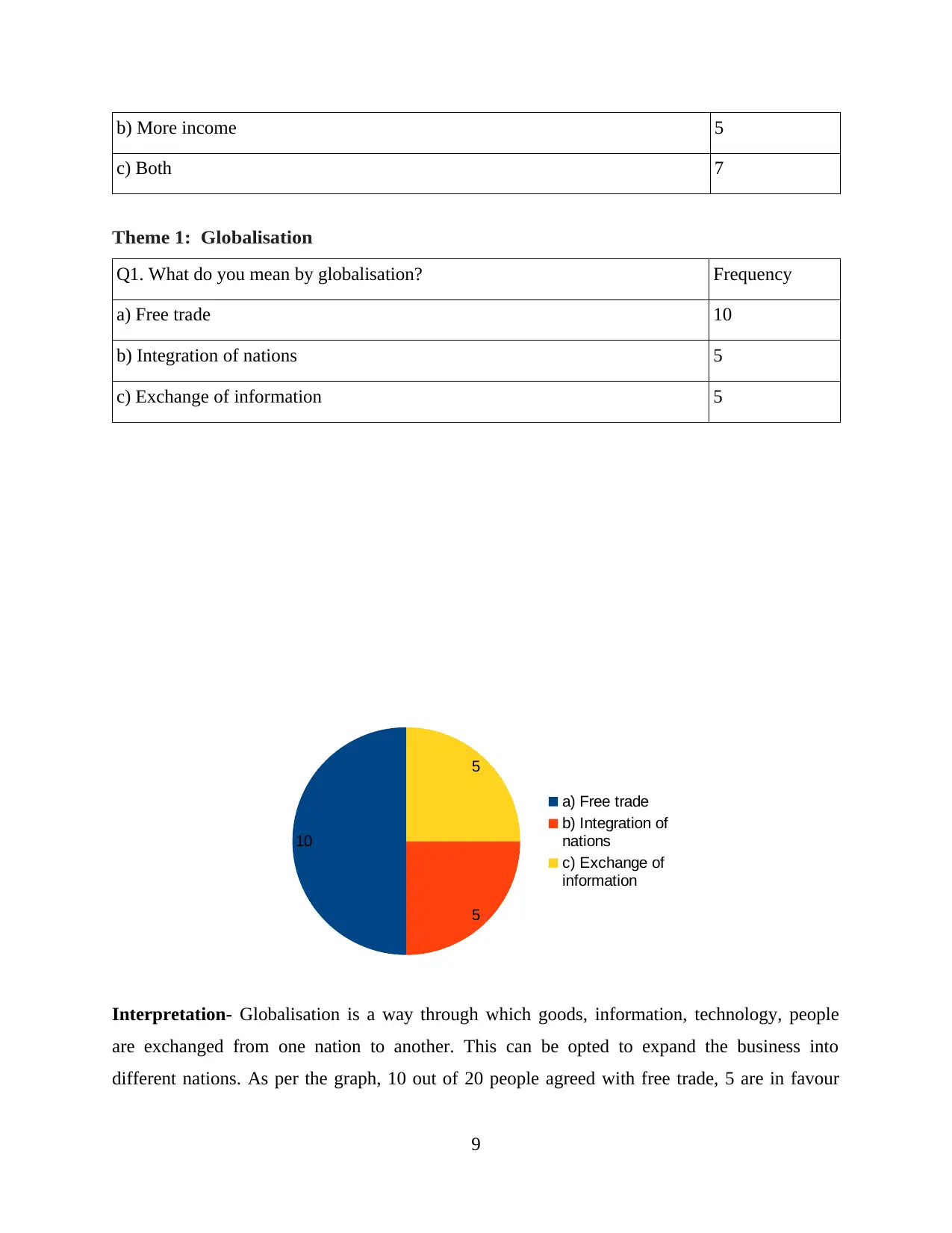
b) More income 5
c) Both 7
Theme 1: Globalisation
Q1. What do you mean by globalisation? Frequency
a) Free trade 10
b) Integration of nations 5
c) Exchange of information 5
Interpretation- Globalisation is a way through which goods, information, technology, people
are exchanged from one nation to another. This can be opted to expand the business into
different nations. As per the graph, 10 out of 20 people agreed with free trade, 5 are in favour
9
10
5
5
a) Free trade
b) Integration of
nations
c) Exchange of
information
c) Both 7
Theme 1: Globalisation
Q1. What do you mean by globalisation? Frequency
a) Free trade 10
b) Integration of nations 5
c) Exchange of information 5
Interpretation- Globalisation is a way through which goods, information, technology, people
are exchanged from one nation to another. This can be opted to expand the business into
different nations. As per the graph, 10 out of 20 people agreed with free trade, 5 are in favour
9
10
5
5
a) Free trade
b) Integration of
nations
c) Exchange of
information
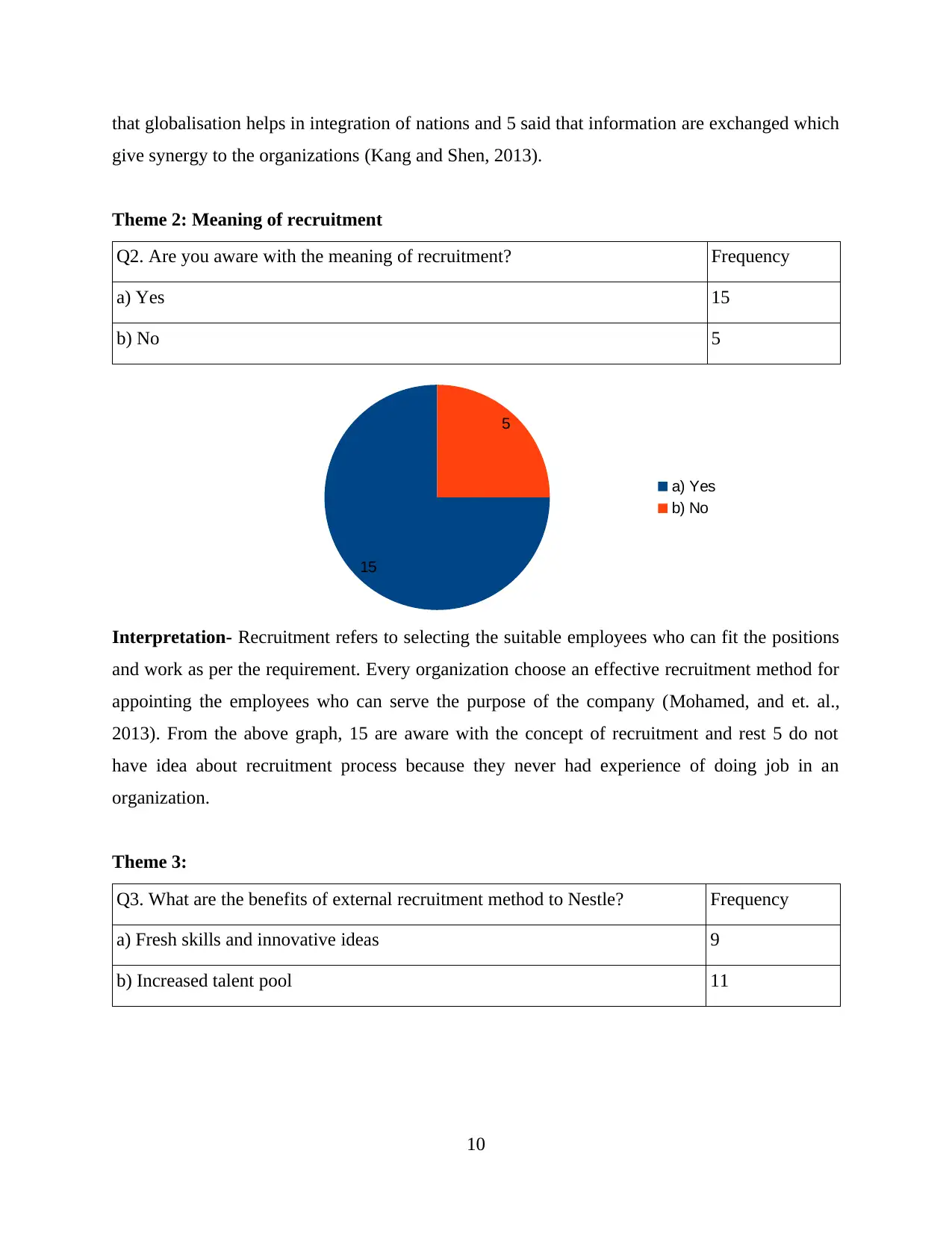
that globalisation helps in integration of nations and 5 said that information are exchanged which
give synergy to the organizations (Kang and Shen, 2013).
Theme 2: Meaning of recruitment
Q2. Are you aware with the meaning of recruitment? Frequency
a) Yes 15
b) No 5
Interpretation- Recruitment refers to selecting the suitable employees who can fit the positions
and work as per the requirement. Every organization choose an effective recruitment method for
appointing the employees who can serve the purpose of the company (Mohamed, and et. al.,
2013). From the above graph, 15 are aware with the concept of recruitment and rest 5 do not
have idea about recruitment process because they never had experience of doing job in an
organization.
Theme 3:
Q3. What are the benefits of external recruitment method to Nestle? Frequency
a) Fresh skills and innovative ideas 9
b) Increased talent pool 11
10
15
5
a) Yes
b) No
give synergy to the organizations (Kang and Shen, 2013).
Theme 2: Meaning of recruitment
Q2. Are you aware with the meaning of recruitment? Frequency
a) Yes 15
b) No 5
Interpretation- Recruitment refers to selecting the suitable employees who can fit the positions
and work as per the requirement. Every organization choose an effective recruitment method for
appointing the employees who can serve the purpose of the company (Mohamed, and et. al.,
2013). From the above graph, 15 are aware with the concept of recruitment and rest 5 do not
have idea about recruitment process because they never had experience of doing job in an
organization.
Theme 3:
Q3. What are the benefits of external recruitment method to Nestle? Frequency
a) Fresh skills and innovative ideas 9
b) Increased talent pool 11
10
15
5
a) Yes
b) No
⊘ This is a preview!⊘
Do you want full access?
Subscribe today to unlock all pages.

Trusted by 1+ million students worldwide
1 out of 20
Related Documents
Your All-in-One AI-Powered Toolkit for Academic Success.
+13062052269
info@desklib.com
Available 24*7 on WhatsApp / Email
![[object Object]](/_next/static/media/star-bottom.7253800d.svg)
Unlock your academic potential
Copyright © 2020–2025 A2Z Services. All Rights Reserved. Developed and managed by ZUCOL.





